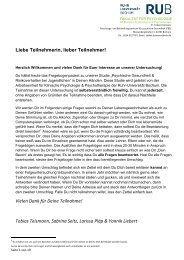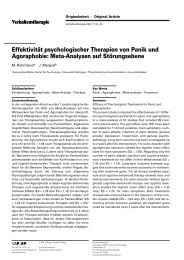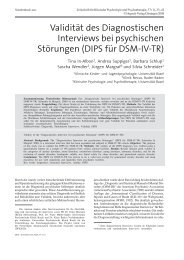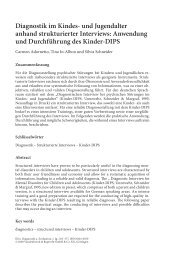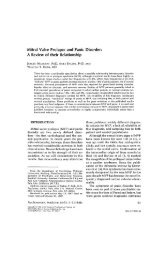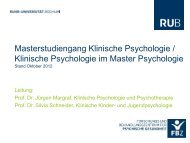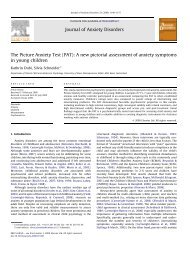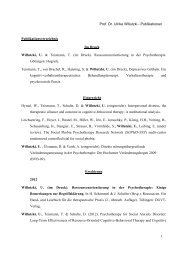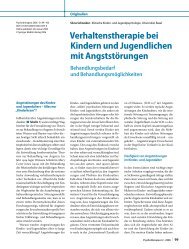Metacognitive Therapy versus Exposure and Response Prevention ...
Metacognitive Therapy versus Exposure and Response Prevention ...
Metacognitive Therapy versus Exposure and Response Prevention ...
You also want an ePaper? Increase the reach of your titles
YUMPU automatically turns print PDFs into web optimized ePapers that Google loves.
<strong>and</strong> group cognitive-behavioral family treatment regarding<br />
efficacy <strong>and</strong> durability of treatment gains. In a very<br />
recent study, the combination of CBT <strong>and</strong> pharmacotherapy<br />
(i.e., sertraline) proved to be superior to CBT<br />
alone <strong>and</strong> to sertraline alone [5] . The effectiveness of ERP<br />
is limited by high rates of treatment rejection <strong>and</strong> dropouts<br />
[7] . This strongly indicates that there is a need for a<br />
psychotherapeutic alternative to ERP. Furthermore, the<br />
efficacy of ERP cannot be attributed solely to habituation<br />
[8] . In some cases, symptom reduction could be better<br />
explained by cognitive changes or by changes in self-efficacy.<br />
This makes cognitive therapy a promising alternative<br />
or additional treatment strategy [9] .<br />
New cognitive <strong>and</strong> metacognitive OCD models [10–<br />
12] led to new intervention techniques – at least in the<br />
treatment of adult patients. Until now, there have been<br />
only a few case studies [13, 14] <strong>and</strong> a case series [15] applying<br />
these new interventions to children <strong>and</strong> adolescents.<br />
OCD – A <strong>Metacognitive</strong> Model<br />
According to the cognitive model of Salkovskis <strong>and</strong><br />
McGuire [16] <strong>and</strong> Wells’ metacognitive model [11, 12] ,<br />
obsessional thoughts develop from normal intrusive<br />
thoughts that are interpreted <strong>and</strong> dealt with in special<br />
ways. OCD patients tend to confuse these thoughts with<br />
real actions, or events, or intentions (metacognitive misinterpretation)<br />
[17, 18] . They tend to make use of several<br />
dysfunctional metacognitive processes, such as increased<br />
cognitive self-consciousness (‘too much thinking about<br />
thinking’) [19, 20] , thought suppression, <strong>and</strong> selective attention<br />
to further intrusive thoughts. Moreover, they often<br />
are not sure when to stop the ritual, <strong>and</strong> make use of dysfunctional<br />
stop signals like ‘emotional reasoning’ (e.g. they<br />
have to repeat the ritual until they ‘feel’ safe or clean).<br />
These various metacognitive appraisals (e.g. thoughtaction<br />
fusion) <strong>and</strong> metacognitive processes (thought control<br />
strategies, selective attention) can be understood as<br />
dysfunctional solutions which lead to further exacerbations<br />
of the vicious cycle of OCD. Recently, Mather <strong>and</strong><br />
Cartwright-Hatton [21] have found these metacognitions<br />
to be good predictors of obsessive-compulsive symptoms<br />
in adolescents <strong>and</strong> proposed a more metacognitively enhanced<br />
therapy.<br />
<strong>Metacognitive</strong> <strong>Therapy</strong><br />
<strong>Metacognitive</strong> therapy (MCT) aims to change dysfunctional<br />
metacognitive appraisals <strong>and</strong> strategies. The<br />
new term ‘metacognitive therapy’ [22, 23] marks the major<br />
differences to st<strong>and</strong>ard cognitive therapy. In the latter,<br />
the contents of thoughts are discussed <strong>and</strong> examined with<br />
regard to their truthfulness <strong>and</strong> probability [24] . In MCT,<br />
the focus does not lie on the content of obsessions <strong>and</strong><br />
intrusive thoughts, but on the appraisal <strong>and</strong> the management<br />
of these thoughts. These thoughts are normalized<br />
by simply accepting them. Furthermore, probability ratings<br />
(e.g. ‘How probable do you think it is that you could<br />
contaminate your parents?’) are seldom useful in OCD<br />
patients. Although they often know that the risk is very<br />
low, they are not sure that they can take it.<br />
In psychoeducation, the patient’s specific problemmaintaining<br />
metacognitive appraisals <strong>and</strong> strategies are<br />
to be discovered, while the therapist emphasizes the normality<br />
of these processes [10] . Socratic dialogue, thought<br />
control experiments, <strong>and</strong> behavioral experiments aim to<br />
change these metacognitive strategies <strong>and</strong> appraisals.<br />
Cottraux et al. [25] conducted one of the few studies<br />
that compare cognitive therapy <strong>and</strong> behavior therapy in<br />
adult OCD. In the present study, the efficacy of MCT for<br />
children <strong>and</strong> adolescents with OCD was investigated. According<br />
to the Task Force criteria of the American Psychological<br />
Association for the identification of empirically<br />
supported treatments [26] , MCT was tested against<br />
the already established ERP treatment. Both treatment<br />
strategies were protocol driven according to two different<br />
manuals written by the first author [22] . It was hypothesized<br />
that both treatment strategies would be effective at<br />
post-treatment <strong>and</strong> would have lasting effects after 3<br />
months <strong>and</strong> after 2 years.<br />
Method<br />
Participants <strong>and</strong> Procedure<br />
Eleven children <strong>and</strong> adolescents (7 males <strong>and</strong> 4 females) with<br />
OCD, aged 8–17 years, participated in the study. All were treated<br />
in a child <strong>and</strong> adolescent psychiatric outpatient setting <strong>and</strong> were<br />
assigned either to narrative ERP or to MCT by simple r<strong>and</strong>omization.<br />
One (male) patient dropped out of MCT, as it dem<strong>and</strong>ed too<br />
much self-reflection on his part. He was successfully treated with<br />
ERP but excluded from further calculations. None of the remaining<br />
10 patients (n = 5 in each group) received pharmacotherapy against<br />
OCD.<br />
All participants were diagnosed according to the DSM-IV/ICD-<br />
10 diagnosis of OCD based on the German structured clinical interview<br />
‘Kinder-DIPS’ [27] with the patients <strong>and</strong> their families <strong>and</strong><br />
on the well-established clinical interview Children’s Yale-Brown<br />
Obsessive Compulsive Scale (CY-BOCS). Patients were excluded<br />
if they had a diagnosis of mental retardation, autism, psychosis,<br />
<strong>and</strong> current treatment using pharmacotherapy for OCD.<br />
Five patients had one or more comorbid diagnoses, including<br />
agoraphobia (n = 2), Tourette’s syndrome (n = 1), chronic tic disorder<br />
(n = 2), <strong>and</strong> attention deficit hyperactivity disorder (ADHD)<br />
(n = 2).<br />
258<br />
Psychother Psychosom 2006;75:257–264<br />
Simons /Schneider /Herpertz-Dahlmann



